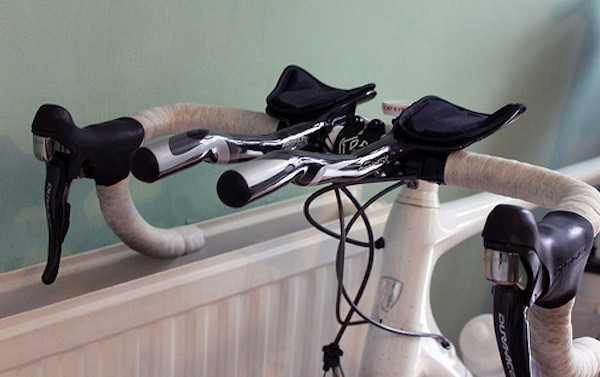 There’s a reason why aero bars are standard equipment on tri-bikes, and it’s not just to make you uncomfortable. Most cyclists who try them testify that, when compared to drop bars, aero bars are awkward or even dangerous, particularly when in the wrong hands. But aero bars do exactly what they’re designed to do, make you faster.
There’s a reason why aero bars are standard equipment on tri-bikes, and it’s not just to make you uncomfortable. Most cyclists who try them testify that, when compared to drop bars, aero bars are awkward or even dangerous, particularly when in the wrong hands. But aero bars do exactly what they’re designed to do, make you faster.
Drop Bars
Most road bikes run drop bars. They’re easily recognized, and very comfortable. On a road bike, aero bars look like a horizontal fork, mounted to the top of drop bars. The prone, forward-leaning position puts your body in an aerodynamic posture, lowering your wind resistance.
Aero Bar Anatomy
Aero bars on triathlon bikes are typically specific to triathlon bikes and you have no other options, you must ride in the aero position. The type that the average cyclists adds to road bikes are aftermarket additions to standard drop bars. Some of them clip on, others bolt on to the bars. Styles may differ slightly, but they all have similar components: Two horizontal extensions with padded cups for your forearms, with grips at the ends of the extensions to steer the bike.
The Position
The real issue with areo bars is the uncomfortable, downward position they place you in. The challenge most cyclists face when they add aftermarket aero bars to a road bike is reach. The seat angle on a road bike is less, as opposed to a tri-bike, and the top tube is longer. This puts stress in the shoulders, since the center of gravity is different. Adding aero bars to a road bike makes you reach further, and thus your torso is overextended. Even if the reach is fine, you’ll feel pressure in your lungs and stomach, and it takes getting used to. It can be done, but some riders never adapt to it, and abandon their areo bars completely.
Bike Fit
No matter what you do, your bike may not accommodate aero bars to their fullest extent. Lots of road bikes are built with relaxed geometry for long distance comfort. The areo bars fit on the bike just fine, but problems with bike fit come into play. If you just can’t get used to the aero bars, it might be beneficial to have a professional scope you out. Moving the seat, replacing the stem or other components on your road bike could make all the difference.
No Brakes
It’s important to note that aftermarket aero bars — the kind you might add to your bike — do not have brakes or shifters. This means you can only use your brakes and shifters by changing hand positions.
Group Riding
The issue with group riding is the fact that your hands are away from the brakes. You shouldn’t be braking in a group ride anyway, but there are times when speed adjustments, or an emergency situation requires quick thinking and quick braking. Changing hand positions in close proximity with other riders can be tricky at best. In addition, group rides also come to intersections. Transitioning from aero bars to drop bars takes time and effort, and doing it over and over again is monotonous not to mention dangerous because you are unable to react quickly enough.
Speed and Efficiency
A common aero bar mistake is staying on them past the point of efficiency. If your speed dips below about 12 mph, you lose most of the benefit of an aero bar. If you’re doing long-distance riding, the torso-forward position gets tiresome. But on the other hand, if it’s windy and you’ve mastered the aero bar, your ride will be more efficient, because you’re not getting beat to death by the wind.
Top Speed
Generally speaking, aero bars can help you be more competitive. Some claim that they add 2 mph or more to your top speed. If you can get used to the position and eventually find them comfortable, you will be faster.
Practice Makes Perfect
It’s already been established that a certain amount of control is lacking when tucked into the aero bar position. Aero bars are inherently twitchy, and hitting a small bump at the wrong time can result in a call to 911. It’s a good idea to practice using aero bars on wide, flat roads. Get comfortable. Ride a few minutes at a time tucked in the aero position, building duration to become more confident. If you master it, riding with aero bars is stable, even more so at speeds above about 15 mph.
Competitive Spirit
If you’ve got a competitive spirit, aero bars can give you the edge. If you’re a recreational rider, aero bars probably won’t be your thing. Aero bar additions are not expensive, and they won’t hurt your bike. Give them a whirl. If they stay on your bike all summer and you haven’t used them, take them off. If you like them, and your competitive spirit continues to influence your riding, keep them on.
Tri-bikes
Tri-bikes add another dimension to speed and efficiency. Not only do they come with aero bars, the geometry of a tri-bike is less forgiving, but faster than standard road bikes. If you’re serious about speed, or time trials, the addition of a tri-bike to your arsenal can make a huge difference.